The World Health Organization has posited that, 10 countries account for 70 per cent of all reported cases and deaths of the novel coronavirus, with just three countries accounting for half.
Speaking to a special session of the agency’s Executive Board, WHO Chief, Tedros Adhanom Ghebreyesus revealed that, not all countries have responded the same way and not all countries have been affected the same way by the virus.
He then outlined some scenarios countries are facing during this crisis saying that, some nations took quick and decisive action against the pandemic, thus avoiding large outbreaks. And while some countries suffered large outbreaks, they were able to bring them under control and suppress the virus.
He further mentioned that, while some countries brought the virus under control, as economies and societies have eased restrictions, there has also been an increase in cases, adding that, there are still some countries in the “intense phase of transmission.”

He stressed that “every situation can be turned around”, underlining the importance of strong leadership, clear and comprehensive strategies, consistent communication, as well as engaging the population.
Touching on funding with regards to curbing the virus, the WHO Chief outlined some priorities for the coming months, which includes increasing funding to ensure all people will have equal access to any potential treatments, hinting on the fact that the northern hemisphere influenza season was fast approaching, and COVID-19 cases increasing in some countries.
Tedros urged countries to realize the full potential of the Access to COVID-19 Tools (ACT) Accelerator, which includes a groundbreaking global collaboration to speed up development of vaccines that will be available to anyone, anywhere who needs them.
The ACT Accelerator was launched in April and has secured around $3 billion so far. However, Tedros said some $34 billion is still required, with $14 billion needed now to maintain momentum.
Besides highlighting the funding gap, Tedros underscored the need to continue to make the most of the tools to fight the pandemic. These range from practicing physical distancing and wearing masks, but also include surveillance, isolation, compassionate care, contact tracing and quarantine.

Dr. Michael Ryan, WHO Emergencies Director, also reported that, more people are still at risk of the virus as the pandemic continues to evolve, with a surge in Southeast Asia, an “upward trajectory” in the northern hemisphere, and an increase in cases and deaths in Europe and the Eastern Mediterranean. He added that the situation in Africa and Western Pacific is currently rather more positive.
“Our current best estimates tell us that, about 10 per cent of the global population may have been infected by this virus. This varies depending on country; it varies from urban to rural; it varies between different groups. But what it does mean is that the vast majority of the world remains at risk.”
“We know the pandemic will continue to evolve. But we also know we have the tools that work to suppress transmission and save lives right now, and they are at our disposal. The future depends on the choices we collectively make about how we use those tools; develop, scale-up and distribute others.”




















